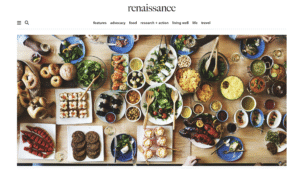Sharing our cultures with others doesn’t just instill pride; it promotes understanding and acceptance. Both seem to be in short supply these days, don’t they?
My client asked its members to share their own particular cultural celebrations, some of which started small and grew to attract hundreds of thousands of participants. My assignment was to follow up and get the details for the Summer 2025 issue of their quarterly magazine, Renaissance. Here they are:
Beyond polka and pierogi, the best festivals celebrate who we are
What is it about cultural celebrations that brings us together?
It’s not just the food, although sharing a meal anchors most festivals and celebrations. The best gatherings celebrate who we are: the languages we speak, the clothes we wear, the music we love, the history and traditions important to us.
‘The world at your doorstep’
That’s why Stephen Rapcewicz and his wife AnneMarie, both retired teachers, have made a point of introducing their children to new cultures in travels at home and abroad. They attend Caribana festivals and cheer at Pride parades. But a favourite is the annual Brantford International Villages Festival, which “puts the world at your doorstep” over four days in July.
Visitors learn about and celebrate the heritage of Filipino, Ukrainian, Polish, Muslim, Pakistani and other cultures through music, dancing, costume displays and food. Volunteers are the heart of the festival, with members from each cultural “village” meeting monthly throughout the year to organize it.
“It’s so wonderful, so friendly, so welcoming and really enjoyable,” Stephen says. “It’s also a great tasting experience – the food is absolutely delicious.”
Reinforcing Indigenous culture
You’ll likely find Wayne Greco at Indigenous gatherings. Retired in 2020, he currently works part-time as principal of an alternative school for Batchewana First Nation, an Ojibway First Nation near Sault Ste Marie in Northern Ontario.
“Growing up, one of the last residential schools was basically in my backyard, but I wasn’t aware of what was occurring within its walls,” he says. “Early in my career, schools paid little, if any, attention to the culture of Indigenous students. Although progress has been made [through the Truth and Reconciliation Commission] towards recognizing, accepting and reinforcing Indigenous culture, much more needs to and must be done.”
Wayne is doing his best to learn and in a small way atone for being part of teaching an incorrect colonial narrative. He attends powwows and has visited sweat lodges, soaking in the traditions and culture of the Batchewana community. He feels privileged to witness the deep spiritual connections, and he finds the traditional foods and dancing to be amazing.
Language is key to a thriving culture
For Nicole McAllister, language is the key to a thriving culture, although food, music and dancing play a big role, too. She grew up in a small French-language community in Northern Ontario and is a proud francophone. Throughout her career with a French-language school board, she always made sure students also valued and took pride in the language and the rich culture.
Nicole’s deep understanding of the importance of language and culture led to work with the Aboriginal Education Office at the Ministry of Education. And as a traveller, she’s interested in the cultures of other countries, like China, Vietnam, India and South Africa.
Retired in 2018, Nicole is proud to chair the event/travel committee for District 4. She loves to participate in the many events offered, such as the annual Réveillon, summer festivals and local Place des Arts. At the Réveillon, she’ll be enjoying classic tourtière and slow-cooked ragout, taking part in the chansons à répondre (where someone sings a line and the crowd answers) and dancing.
Filipino culture and folk dancing
Susan (Susie) Rialp attends Filipino events and folk festivals put on by the Victoria Filipino Canadian Association. Susie immigrated to Canada from the Philippines and wanted her two daughters to be reminded of the Filipino culture that is part of their identity. Now adults, both have been folk dancing since they were four years old. They have also attended summer festivals and the Independence Day celebrations on June 12, which include music, dancing and food. Particular favourites: chicken adobo, Filipino pancit (noodles) and leche flan.
Susie is a long-time supporter of the association, including acting as vice-president in the 1990s. Now she attends the events and supports them in various other ways, like writing letters or creating posters. She’s retired from teaching and is almost finished writing a novel about Filipino martial law and a teenager coming of age that also connects to her culture.
Inclusion helps people see themselves reflected in the community
The celebrations Joan Beecroft loves best focus on inclusion. “That’s important to me because people need to see themselves reflected in community events,” she explains. “They’re a great way to learn and teach about other cultures, including LGBTQ families.”
Joan and her partner are part of the 2SLGBTQIA+ community, and particularly support Grey Bruce Pride, PFLAG (Parents, Families and Friends of Lesbians and Gays) and the Grey Bruce One World Festival, which celebrates diversity and inclusion. In fact, Joan founded Grey Bruce Pride herself in 2006 after a “furor” over raising the rainbow flag in Owen Sound. From a series of picnics and concerts in a municipal park, it’s grown to a parade followed by a street fair with music and community booths.
After answering emails and phone calls for PFLAG, she was also asked to start the PFLAG Canada Owen Sound group in 2014. It hosts a variety of events that bring participants together to celebrate. She has also worked with the One World Festival, which celebrates diversity in the area and is aimed at elementary students.
“I want everyone, regardless of any minority or majority status, to realize we’re all part of the same community,” she says.
North America’s largest celebration of Polish culture
Barbara Grabowski is a big fan of the two-day Roncesvalles Polish Festival. Put on by the local business improvement organization, it’s held on Roncesvalles Avenue in Toronto’s West End every September. The festival is North America’s largest celebration of Polish culture, drawing hundreds of thousands of people each year.
“I’m Polish and I live in the area, so I go often,” Barbara says. “The festival brings people together and it’s important to support it. More than just polka and pierogi, you can see performances by talented local artists and musicians, taste different foods, visit the beer garden and shop vendors, some of whom bring in products directly from Poland.”
Folk art promotes understanding and acceptance
Over the years, Virginia MacLean participated in Israeli dancing at the Folk Arts Festival in St. Catharines, which turned 57 in May. The festival uses art to promote understanding and acceptance among the different cultures that make up Canada, keeping cultural traditions alive and sharing them with the community.
“After the pandemic, I joined the Scottish ceilidh group at the festival,” Virginia says. Sadly, the two dance groups are no longer running so she’s hung up her dancing shoes.
From one-time celebration to the longest-running multicultural festival
Angela Osterreicher celebrates the cultural fabric of Manitoba by attending the city’s annual Folklorama Festival. What started as a one-time celebration of Manitoba’s centennial in 1970 is now the largest and longest-running multicultural festival of its kind in the world. Over two weeks in August, its 40 pavilions celebrate diversity and the unique traditions, food, language and entertainment of various cultures.
Angela is of Austrian heritage, and likes to learn about cultures she would be unlikely to experience in person elsewhere. Over the years, she has visited pavilions representing Indigenous, Afro-Caribbean, Italian, Ethiopian, German, Irish and other cultures.
“I deeply enjoy learning about different cultures, sampling their cuisine and watching their vibrant performances,” she says. “As a recent retiree, I’ve opted for the VIP experience, which includes transportation between venues, expedited entry and table service for meals. This allows me to savour appetizers at one pavilion, enjoy a main course at another, and finish with dessert at a third – all without the hassle of waiting in line.”
Rural community treasures multiple cultural traditions
Alfred (Fred) Guidolin meets monthly with the Multicultural & Heritage Association of Norfolk to plan community heritage days and school presentations showcasing the area’s cultural traditions. “We also participate in festive parades and host an annual Christmas dinner, and generally celebrate our love of food,” he adds.
The rural community became home for many immigrants who farmed there before and after the Second World War. At one time, the town of Delhi had a Polish Hall, Hungarian and German Homes, and Belgian and Portuguese Halls. Most recently, they welcomed Ukrainian immigrants. Fred’s own background is Italian. All share the common theme of treasuring their cultural traditions, language, food and celebrations.
“Finding similar experiences and the immigrant story translated in various languages and ethnic settings is a marvel,” Fred notes. “So many stories and histories have parallels. The separation of families from their homeland, learning a new language, establishing homes and raising families, maintaining traditions and family connections with letters and visits – all these are a common thread in our multicultural association.”
In their own way, cultural celebrations are a perfect way to bring people together. And as one participant at a Norfolk celebration said, “We get along so well in our community with our multicultural neighbours; why can’t the rest of the world do the same?”
Related reading:
Learn about regrets and do-overs
How’s dating the second time around?
Members share their simple pleasures

